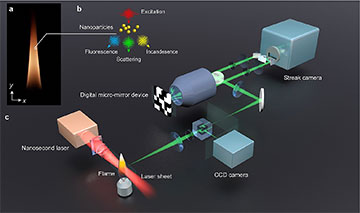Top left: A photograph of a kerosene flame with an illustration of the three optical signals emitted when nanoparticles (soot or PAH molecules) in the flame interact with the nanosecond laser-sheet. Center: Schematic of the laser-sheet compressed ultrafast photography (LS-CUP) imaging system. [Image: Y.N. Mishra, P. Wang, F. Bauer, Y. Zhang, D. Hanstorp, S. Will and L.V. Wang] [Enlarge image]
Despite all the advances in renewable sources of electricity, civilization still relies heavily on the combustion of hydrocarbons, from cooking fires to jet engines. But many of the details of the burning process have remained just out of reach for scientists and their imaging systems.
Now an international team has captured details of laser-flame interactions with a billion-frames-per-second laser-sheet camera (Light Sci. Appl., doi: 10.1038/s41377-023-10195-5). The researchers say the technique could uncover answers to other longstanding questions in plasma physics.
Products of fuel combustion
Burning fossil fuel releases nanoscale particles of soot and soot’s precursors, known as polycyclic aromatic hydrocarbons, or PAHs. PAH molecules, which are also found in the interstellar medium and star-forming regions out in the universe, can lead to cancer and other ailments when they penetrate human lungs on Earth. Yet scientists have practical uses for carbon-based nanoparticles formed in flames, from fuel cells to quantum dots.
The turbulence in combustion occurs in the millisecond-to-microsecond time scale, but some of the chemical products exist for only microseconds to picoseconds. Imagers that produce millions of frames per second (Mfps) work to capture the process in some experiments but have severe limitations in other situations.
Over the past decade, newer imaging techniques such as compressed ultrafast photography and planar imaging based on laser sheets have led to improved studies of combustion. In the latest work, researchers from universities in the United States, Sweden and Germany combined the two modalities into one method, calling it single-shot laser-sheet compressed ultrafast photography (LS-CUP), to study the laser-induced fluorescence of PAHs and other details of soot formation.
The LS-CUP setup
In the experiment, a nanosecond pulsed Nd:YAG laser excited the combustion products within a small kerosene flame. A convex cylindrical lens between the laser and the flame created a 0.4-mm-thick laser sheet 10 mm in height. The imaging system, at right angles to the path between the laser and the flame, incorporated a streak and a digital micro-mirror device, among other components.
At imaging speeds of 1.25 billion frames per second (Gfps) up to 12.5 Gfps, the LS-CUP setup captured 2D snapshots of interactions between PAHs and the soot molecules they produce.
According to Yogeshwar Nath Mishwa of the California Institute of Technology (Caltech), USA, and the University of Gothenburg, Sweden, the technique images non-repeatable laser-flame interactions that produce both incandescence and fluorescence. “Further, we can apply LS-CUP for real-time observation of hydrogen combustion, plasma-assisted combustion and metal powder combustion—some of the recent hot topics in the field,” he said in a press statement. “Temperature is a crucial property in many thermodynamic systems, and to the best of our knowledge, we have reported its fastest wide-field measurements.”
Mishwa collaborated with Peng Wang, also of Caltech, and other researchers from Caltech and the University of Erlangen-Nuremberg, Germany. Optica Fellow Lihong V. Wang supervised the project.


